A Winning Web Developer Resume That Gets Noticed
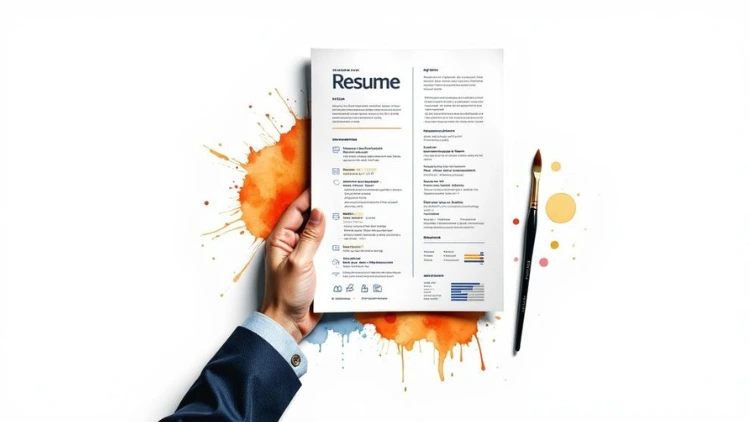
Your resume is so much more than a dry list of skills and job titles. For a web developer, it’s your number one marketing tool. It needs to tell a compelling story about your problem-solving chops and the real-world impact you deliver.
Think of it this way: your resume isn't a passive document. It’s an active sales pitch designed to grab a recruiter’s attention in just a few seconds.
Jump To Section

Earn As You Learn
Earn 25% commission when your network purchase Uplyrn courses or subscribe to our annual membership. It’s the best thing ever. Next to learning,
of course.
Your Resume is More Than a List of Skills
Let's be real—the tech job market is packed. Just listing out your programming languages won't cut it anymore. Your resume has to frame your experience around what you achieved, not just what you were told to do.
This guide goes beyond the basics. We're going to show you how to build a resume that not only glides past the Applicant Tracking Systems (ATS) but actually makes a hiring manager stop and take notice. We'll get into actionable ways to tell a compelling story about your project wins and how you tackle tough problems.
Shifting Focus from Duties to Impact
The single biggest mistake we see developers make is describing their past jobs as a list of duties. A hiring manager already knows what a web developer does; they want to know what you accomplished.
For example, here's a common but totally ineffective bullet point:
- "Responsible for maintaining the company's e-commerce website."
Okay, but what did you actually do? Let’s reframe that to show some real impact:
- "Reduced average page load time by 35% by implementing image optimization and code-splitting techniques, boosting user engagement."
See the difference? The second one is powerful because it uses a hard number (35%) to prove a tangible business outcome. This is the secret sauce of a modern web developer resume. You can dig deeper into what skills to list in a professional CV to get more ideas on framing your abilities.

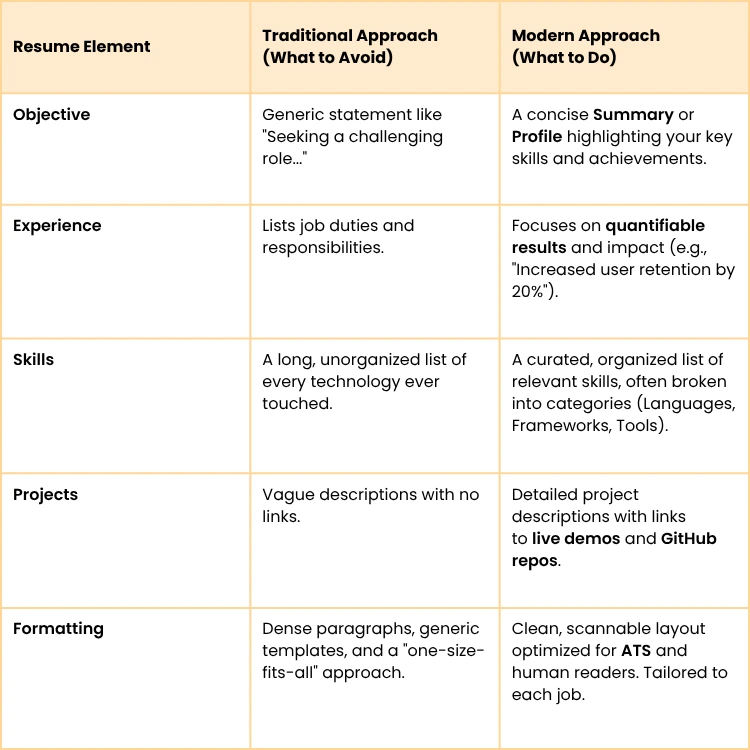
Navigating a Competitive Market
Good news: the demand for skilled developers is still strong. The U.S. Bureau of Labor Statistics projects that web developer employment will grow by about 7-8% from 2024 to 2034. That translates to roughly 14,500 new job openings popping up each year.
But more opportunity also means more competition.
Your resume is the first test of your ability to communicate complex information clearly. If your resume is a wall of text, a recruiter might just assume your code is, too.
To stand out, your resume absolutely must be scannable, targeted, and focused on results. Forget the generic templates. Your goal is to build a clear narrative about the value you bring to the table. That means zeroing in on:
- Quantifiable Achievements: Use numbers, percentages, and dollar amounts to prove your worth.
- Problem-Solving Stories: Briefly set the scene: what was the challenge, what action did you take, and what was the positive result?
- Tailored Content: Tweak your resume for every single job you apply for. Match your skills to their requirements.
When you adopt this mindset, your resume transforms from a boring history lesson into a persuasive argument for why you’re the best person for the job. And that’s what gets you in the door.
Building the Foundational Resume Sections
Alright, let's get down to actually building your resume. Think of these sections as the essential architecture—the framework that holds your professional story together. Getting them right makes it incredibly easy for a recruiter to see your value at a glance. Each piece has a job to do, and nailing them is non-negotiable.
Nail Your Contact and Professional Links
This part seems obvious, but it’s your first chance to show you’re a pro who pays attention to detail. It needs to be clean, scannable, and packed with links that prove you can actually code. Don't make anyone hunt for this info.
- Professional Email: Keep it simple, like firstname.lastname@email.com. Ditch the cringey handles from high school.
- Phone Number: Just your current mobile number. That's it.
- Location: City and State are all you need. No one needs your full street address anymore.
- LinkedIn Profile: Make sure you've customized your LinkedIn URL (e.g., linkedin.com/in/yourname). It’s a small detail that signals you’re on top of your game.
- GitHub Profile: This is your portfolio. For a developer, it's absolutely essential. Make sure it's active and you’ve pinned your best work right at the top.
Ditch the Objective for a Compelling Professional Summary
Let's be clear: the old-school "resume objective" is dead. No hiring manager cares that you're "seeking a challenging role". What they do care about is what you can do for them.
Replace it with a powerful Professional Summary. This is your 3-line elevator pitch, sitting right under your contact info, that immediately answers the recruiter's biggest question: "Why should I care?"
Practical Examples of Professional Summaries
- For a Junior Developer: "Detail-oriented Junior Web Developer with a strong foundation in React and Node.js. Passionate about building responsive, user-friendly applications and skilled in modern JavaScript frameworks. Eager to apply problem-solving abilities and a collaborative spirit to contribute to a dynamic development team."
- For a Mid-Level Developer: "Results-driven Full-Stack Developer with 4+ years of experience designing and implementing scalable web applications using TypeScript and Python. Proven ability in optimizing application performance, leading to a 20% reduction in API latency in a previous role. Seeking to leverage expertise in cloud services (AWS) to build robust back-end systems."
- For a Senior Developer: "Seasoned Senior Front-End Developer with over 8 years of experience architecting complex, high-traffic user interfaces for SaaS platforms. Expert in React, Redux, and performance optimization, with a track record of mentoring junior engineers and improving development workflows. Successfully led a component library migration that increased developer velocity by 30%."
Your summary is your hook. It’s the first thing a recruiter reads and your best chance to make a strong initial impression. Make every word count by focusing on your unique value and key accomplishments.
The job market is still hot for developers with the right skills. For example, back in January 2025, there were roughly 227,881 web developer jobs posted in the U.S. alone. This demand is increasingly shaped by trends like AI and Web 3.0, so showcasing modern skills is more important than ever.
Strategically Organize Your Technical Skills
A giant, unorganized block of tech buzzwords is a huge turn-off. It screams, "I just threw everything at the wall to see what sticks". It's hard to read and doesn't do you any favors with Applicant Tracking Systems (ATS), either.
A much smarter approach? Break your skills into logical categories. This simple tweak makes your expertise instantly clear.
Example Skills Section Format
- Languages: JavaScript (ES6+), TypeScript, HTML5, CSS3/SASS, Python, SQL
- Frameworks/Libraries: React, Node.js, Express.js, Vue.js, Django
- Databases: PostgreSQL, MongoDB, Redis
- Tools & Platforms: Git, Docker, AWS (S3, EC2), Webpack, Jest, Figma
This is so much cleaner and more effective than a jumbled list. If you're targeting remote work, checking out some work-from-home resume samples can give you more ideas on how to structure this.
Prioritize Education and Certifications
Where you put your education section really depends on where you are in your career.
If you're a recent grad or junior dev, your education is a major asset. Place it high up, right after your summary. Be sure to include your degree, university, graduation date, and any impressive academic achievements (like a high GPA). Bootcamp certificates are golden here, too.
For experienced developers, your hands-on work is what matters most. Move the education section to the bottom. A simple line with your degree, university, and graduation year is plenty. If you have credentials like an "AWS Certified Developer" certificate, give them their own "Certifications" subsection to make them stand out.
You can get an even more detailed guide on how to write a resume that will actually get a recruiter's attention on our blog.
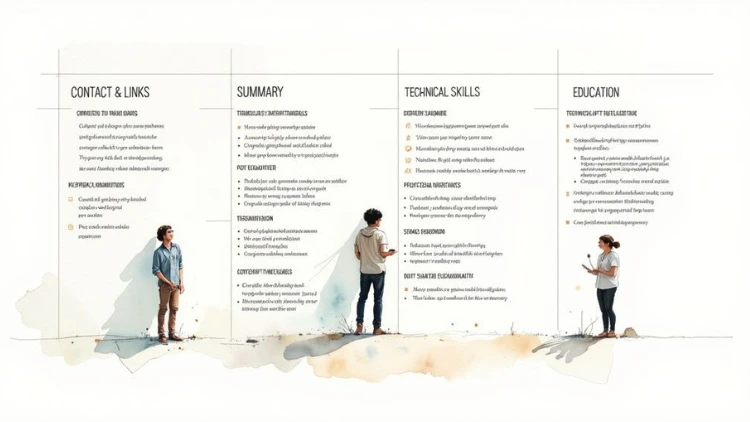
Showcase Your Impact with Projects and Experience
Alright, this is where your resume really starts to sing. We've laid the groundwork with your contact info, summary, and skills. Now it's time to bring the proof. Your professional experience and personal projects are what will set you apart, shifting your resume from a simple list of duties to a powerful showcase of the value you deliver.
Curate a High-Impact Projects Section
For junior developers or career-changers, your projects section might just be the most important piece of real estate on your resume. It’s your portfolio in a nutshell—the ultimate proof that you can apply your knowledge to build actual, working software.
This isn't the place to list every tutorial you've ever finished. Quality beats quantity every time. Your goal should be to showcase two to three of your most impressive and relevant projects. And for each one, go deeper than just listing the tech stack.
What to Include for Each Project:
- Project Title: A clear, descriptive name.
- Tech Stack: List the primary languages, frameworks, and tools you used.
- Project Description (1-2 sentences): A quick pitch on what the project does and the problem it solves.
- Your Contributions (2-3 bullet points): Detail your specific role and the cool features you built. You can use the PAR method described below, too!
- Links: Always include a link to the live demo and the GitHub repository. This is non-negotiable.
Practical Examples of Project Descriptions
Let’s see what this looks like in practice for a couple of different project types.
Example 1: Full-Stack E-commerce App
- Project Title: Artisan Goods Marketplace
- Tech Stack: React, Node.js, Express, PostgreSQL, Stripe API
- Description: A full-stack web application that allows local artisans to create storefronts and sell their products online.
- Contributions:
- Engineered a secure RESTful API with Node.js to handle all user authentication and product management logic.
- Integrated the Stripe API for payment processing, creating a secure and reliable transaction flow for customers.
- Developed a fully responsive front-end with React, delivering a seamless shopping cart experience on any device.
- Links: [Live Demo] [GitHub Repo]
Example 2: Front-End Data Visualization Tool
- Project Title: Global Weather Dashboard
- Tech Stack: Vue.js, Chart.js, OpenWeatherMap API
- Description: A client-side application that visualizes real-time weather data for cities around the world using an external API.
- Contributions:
- Built a dynamic UI in Vue.js that lets users search for cities and view interactive, easy-to-read weather charts.
- Managed all asynchronous API calls to fetch and render weather data efficiently, ensuring a fast, lag-free user experience.
- Links: [Live Demo] [GitHub Repo]
These examples work because they don't just state what was built; they explain the purpose and highlight specific, valuable contributions. If you're looking for inspiration, this guide on 18 Node.js project ideas offers a great starting point for building portfolio-worthy applications. By meticulously detailing your experience and projects, you create a resume that stands out and tells a compelling story of what you can do.
Frame Your Experience with the PAR Method
Too many developers make the mistake of treating their experience section like a laundry list of job responsibilities. A recruiter already knows the basics of what a "Web Developer" does; they need to know what makes you different. The key is to show, not just tell.
There's a simple but incredibly effective way to write bullet points that grab attention: the Problem-Action-Result (PAR) framework. Think of it as a mini-storytelling formula. It forces you to stop thinking about your tasks and start thinking about your impact. It turns a passive duty into a measurable achievement.
Here’s the breakdown:
- Problem: What was the challenge or goal you were up against? This gives the hiring manager context.
- Action: What, specifically, did you do to tackle it? This is where you highlight your skills and proactivity.
- Result: What was the tangible, positive outcome? This is where you prove your worth with hard numbers.
Let's walk through a real-world example. Instead of a vague statement like "Worked on the backend API", you can use PAR to craft something far more compelling.
Before (Just a duty):
- Worked on the backend API for the e-commerce platform.
After (Using PAR):
- Problem: The company's e-commerce platform was struggling with slow API response times during peak traffic.
- Action: I jumped in, identified the inefficient database queries, and implemented a new caching layer using Redis.
- Result: The changes reduced the average API response time by 200ms, which directly supported a 15% increase in successful checkouts during major sales events.
When you merge this into a single, punchy bullet point for your resume, it tells a complete story of your contribution.
Actionable Insight: Pull up your current resume right now. For every bullet point under your experience, ask yourself: What was the problem? What did I do? What was the measurable result? If you can't answer all three, it’s time for a rewrite using the PAR method.
This visual perfectly illustrates how reframing your accomplishments can make a world of difference.
The takeaway is simple: specificity and numbers are your best friends. Vague statements are forgettable, but quantified results demonstrate undeniable business value.
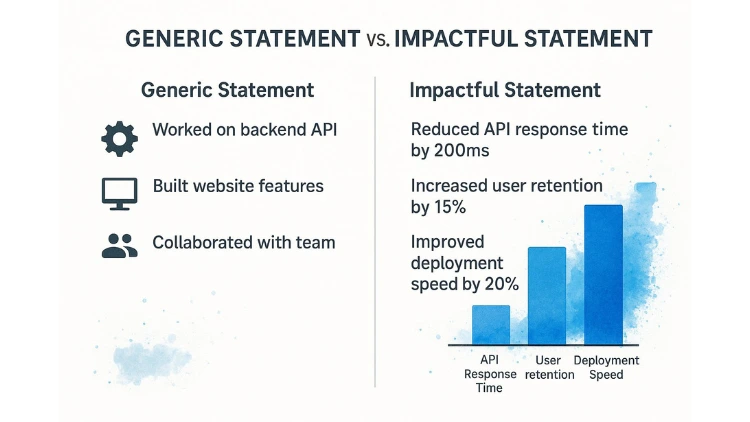
Optimize Your Resume for Robots and Humans
Before a human recruiter ever lays eyes on your resume, it has to get past a digital gatekeeper first. That gatekeeper is the Applicant Tracking System (ATS), and a shocking 75% of resumes are rejected by these systems before a person even sees them. Your first job is to build a resume that this robot understands.
But that’s only half the battle. Once you’re through, your resume lands in front of a real person who will spend maybe seven seconds glancing at it. That's your tiny window to make an impression. So, you have to create a document that is both machine-readable and compelling to a human eye. It’s a bit of a balancing act, but it's totally doable.
First, Pass the ATS Test
Think of the ATS as a very literal-minded assistant. It doesn’t care about fancy graphics, creative layouts, or unique fonts. It’s simply scanning for specific information in expected places. To make your resume ATS-friendly, you have to play by its rules.
Here’s how you get past the bots:
- Stick to Standard Section Titles: Don't get cute with your headings. An ATS looks for terms like "Professional Experience", "Technical Skills", and "Education". Calling your work history "My Coding Adventures" might feel creative, but the software will just get confused and skip it.
- Use ATS-Friendly Fonts: Stick with the classics. Fonts like Arial, Helvetica, or Calibri are clean, readable, and easily parsed by software. Anything too stylized or script-like is a recipe for getting your resume garbled.
- Incorporate Keywords Naturally: This is a big one. The ATS is programmed to hunt for keywords directly from the job description. Go through the posting and pull out the key technologies ("React", "Node.js", "AWS") and skills ("Agile methodologies", "API design"). Then, weave these terms into your summary, experience, and skills sections where they make sense. Don't just list them; build them into your accomplishment bullet points.
Actionable Insight: Copy the text of the job description you're targeting and paste it into a free word cloud generator. The biggest words that appear are your most important keywords. Make sure those are prominently and naturally featured in your resume.
Then, Design for the Seven-Second Scan
Once you’ve cleared the ATS hurdle, it’s time for the human test. Remember, a recruiter is likely staring at a mountain of applications. A resume that’s a dense wall of text is an instant turn-off. Your design needs to scream "scannable".
Your goal here is simple: guide the reader’s eye directly to your most impressive qualifications.
Actionable Tips for Human Readability
- Embrace White Space: Don't cram everything in. Generous margins and spacing between sections make your content feel less intimidating and much easier to read.
- Create a Clear Visual Hierarchy: Your name and section headings should pop. Use a slightly larger font or bold text for titles like "Projects" and "Experience" to act as signposts for the reader.
- Keep Bullet Points Short and Punchy: Aim for one to two lines per bullet point. This forces you to be direct and makes your accomplishments easy to digest in a quick scan. Nobody is going to read a six-line bullet point.

Balancing ATS and Human Needs
It's a classic tug-of-war: what works for a machine can feel a bit bland for a human, and a visually stunning resume might be completely unreadable to an ATS. The sweet spot is a resume that’s both machine-friendly and visually engaging.
You don't have to sacrifice good design, but your choices need to be strategic. The table below breaks down how to strike that perfect balance for key components of your resume.
Ultimately, a winning web developer resume speaks two languages: the keyword-driven dialect of the ATS and the impact-driven language of the hiring manager. By focusing on a clean structure, standard formatting, and content that’s both keyword-rich and results-focused, you'll create a document that nails both conversations.
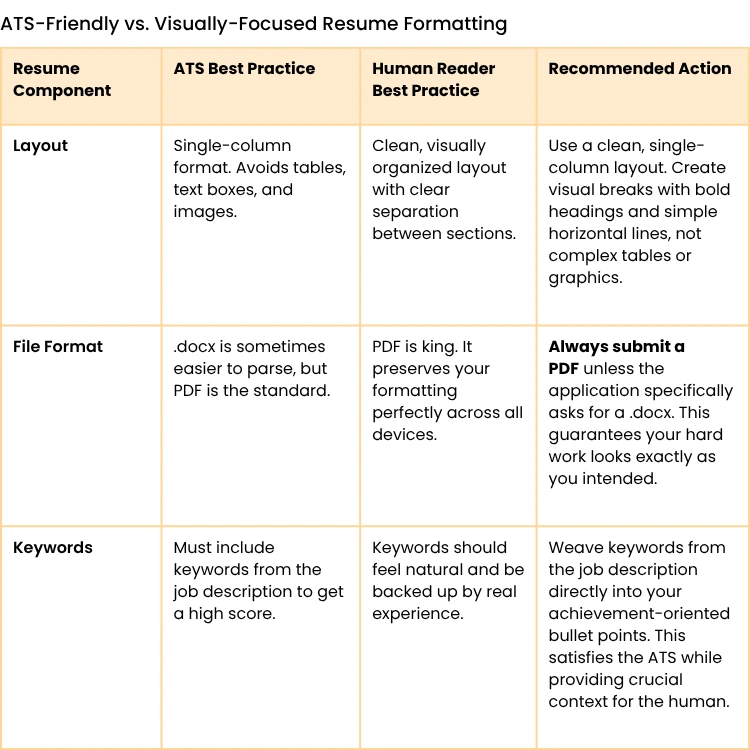
Don't Send the Same Resume Everywhere—Tailor It
Sending out a generic, one-size-fits-all resume is the quickest way to land in the "no" pile. Think about it: a Front-End Developer role is worlds apart from a Back-End role, even if they're both under the "developer" umbrella. They require different skills, different priorities, and a completely different mindset.
A generic resume just tells the recruiter you haven't bothered to understand the specific job you're applying for.
Taking just 10 minutes to tweak your resume before hitting "apply" can be a game-changer. It shows you’re paying attention and you’re genuinely interested in this role, not just any role. That’s a massive plus in any hiring manager's book.
Customizing for a Front-End Developer Role
When a company is looking for a front-end dev, they want someone obsessed with the user experience. Your resume needs to scream that you love building beautiful, fast, and intuitive interfaces.
Your mission here is to showcase your mastery of client-side tech and your knack for turning designs into flawless code.
- Talk about your UI/UX collaboration. Did you work with designers using tools like Figma, Sketch, or Adobe XD? Mention it.
- Show off your framework skills. Make sure your experience with React, Vue, or Angular is front and center.
- Bring up performance. Did you improve Core Web Vitals, slash load times, or optimize the rendering path? Recruiters love seeing this.
- Don't forget testing. Experience with tools like Jest or Cypress shows you’re serious about quality.
Reframing for a Back-End Developer Role
For back-end positions, the spotlight shifts completely. No one cares about pixel-perfect layouts; they care about the server, the database, and the application's core logic. The recruiter is looking for solid proof that you can build a system that's robust, scalable, and secure.
Your resume has to prove you can wrangle data, manage server operations, and build powerful APIs.
- Focus on API design. Talk about your experience building and maintaining RESTful or GraphQL APIs.
- Highlight your database chops. Whether it’s SQL (PostgreSQL, MySQL) or NoSQL (MongoDB), make it clear you know your way around a database.
- Mention scalability and security. How have you handled scaling an application? What did you do to patch security holes or protect user data?
- List your server-side languages. Make sure your expertise in Node.js, Python (Django/Flask), or Java (Spring) is impossible to miss.
Pivoting a Single Project for Different Roles
The best way to see this in action is with a real example. Let’s take one project—a full-stack e-commerce app—and see how we can frame it for both a front-end and a back-end job application.
Here’s the generic, original bullet point:
- Built a full-stack e-commerce platform using React and Node.js to sell artisan goods.
It’s fine, but it’s not great. Now, let’s give it a makeover.
Front-End Version (All about the UI/UX):
- Developed a responsive and accessible shopping cart experience using React and Redux, resulting in a 25% increase in mobile conversions.
- Collaborated with a UX designer to translate Figma mockups into a pixel-perfect component library, ensuring a consistent brand identity across the application.
Back-End Version (Focusing on APIs and Data):
- Engineered a secure RESTful API with Node.js and Express to manage user authentication, product inventory, and order processing.
- Designed and optimized a PostgreSQL database schema to handle high-volume transactions, reducing query latency by 30% during peak traffic.
See the difference? The core project is exactly the same, but the language and focus are tailored perfectly to the role. This simple tweak makes your experience instantly relevant. If you want more tips on positioning yourself, this guide on how to get a software engineering job dives deeper into these strategies.
It's also worth noting that salaries can vary quite a bit depending on your experience, location, and specialization. While the software engineering job market has seen its ups and downs heading into 2025, the demand for specialized skills, particularly in areas like AI, continues to create strong opportunities for developers who know how to market themselves. For more on this, the software engineering job market trends offer some great insights.
Your Top Web Developer Resume Questions, Answered
Writing a resume can feel like navigating a minefield, especially in tech. Even developers who’ve been in the game for a while run into the same questions over and over. Let's clear up some of the most common confusion with straightforward advice you can actually use.
How Long Should My Resume Be?
For almost anyone with less than 10 years of experience, the answer is simple: one page. Stick to it.
This isn't just about tradition; it's about making an impact. A single page forces you to be ruthless and showcase only your most impressive, relevant accomplishments. Recruiters spend just a few seconds on that first glance, so a dense, powerful document will always beat a long, rambling one.
The only real exception is for senior-level developers or tech leads with a long and storied career full of high-impact projects that just can't be squeezed onto a single page without losing their punch.
Should I Put a Photo on My Resume?
If you're applying for jobs in the U.S., Canada, or the UK, the answer is a hard no. Including a photo can invite unconscious bias into the hiring process, and most companies are actively trying to eliminate that.
There's a technical reason, too. Photos, logos, and other fancy graphics can completely trip up Applicant Tracking Systems (ATS). The last thing you want is for your resume to get tossed into the digital trash bin before a human ever lays eyes on it. Let your skills and experience do the talking.
Your resume is the hook, designed to be so compelling that the recruiter wants to see more. Your portfolio is the deep dive—the undeniable proof of your abilities. Your resume earns the click; your portfolio lands the interview.
What Are the Biggest Red Flags on a Developer Resume?
Recruiters see the same mistakes again and again. Just knowing what they are puts you miles ahead of the competition.
Here are a few of the most common red flags to watch out for:
- Typos and Grammatical Errors: This is a big one. It signals a lack of attention to detail, which is a death sentence for a developer. Proofread it, then have someone else proofread it again.
- An Unprofessional Email Address: It’s time to retire cooldevguy89@email.com. Use a simple, professional format like firstname.lastname@email.com.
- Listing Tech Without Proof: Don’t just list a dozen technologies. If you claim you know React, we want to see a project or a work experience bullet point that proves it. Otherwise, it’s just noise.
- Focusing on Duties, Not Achievements: Nobody wants to read that you were "responsible for coding". That’s a given. Show them what you accomplished. Saying you "cut page load time by 40% by refactoring the rendering process" is infinitely more powerful.
Steering clear of these common pitfalls is a huge first step. It also pays to think one step ahead. Once your resume lands you that first call, you might face a screening interview or even a pre-recorded one. Knowing what to expect is key, so check out these tips to ace your pre-recorded interview to get prepared.
Ready to build the skills that will fill your resume with high-impact achievements? At Uplyrn, we provide the courses and expert guidance you need to excel in your web development career. Explore our courses today!


Leave your thoughts here...
All Comments
Reply